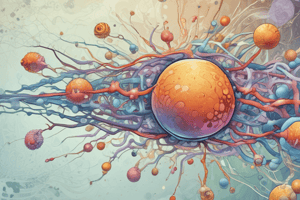Podcast
Questions and Answers
Which microorganism is responsible for tuberculosis?
Which microorganism is responsible for tuberculosis?
- Staphylococcus bacteria
- Mycobacterium Tuberculosis (correct)
- Bacillus Anthracis
- Penicillium notatum
John Tyndall discovered the method of sterilization known as Tyndallization.
John Tyndall discovered the method of sterilization known as Tyndallization.
True (A)
What compound did Joseph Lister use to sterilize surgical instruments?
What compound did Joseph Lister use to sterilize surgical instruments?
carbolic acid
The vaccine developed by Edward Jenner was for __________.
The vaccine developed by Edward Jenner was for __________.
Match the following scientists with their contributions:
Match the following scientists with their contributions:
What is the primary purpose of vaccination?
What is the primary purpose of vaccination?
Viruses are larger than bacteria.
Viruses are larger than bacteria.
Which antibiotic was discovered by Paul Waksman for tuberculosis?
Which antibiotic was discovered by Paul Waksman for tuberculosis?
Which branch of microbiology studies fungi?
Which branch of microbiology studies fungi?
Robert Koch is known for developing the theory of spontaneous generation.
Robert Koch is known for developing the theory of spontaneous generation.
Who is known as the 'Father of Microbiology'?
Who is known as the 'Father of Microbiology'?
Louis Pasteur developed the method of __________ to kill harmful microorganisms in food.
Louis Pasteur developed the method of __________ to kill harmful microorganisms in food.
Match the following pioneers of microbiology with their contributions:
Match the following pioneers of microbiology with their contributions:
What is the primary focus of medical microbiology?
What is the primary focus of medical microbiology?
John Needham's experiment supported the Theory of Spontaneous Generation.
John Needham's experiment supported the Theory of Spontaneous Generation.
What was the main conclusion of the Swan-Neck Flask experiment conducted by Louis Pasteur?
What was the main conclusion of the Swan-Neck Flask experiment conducted by Louis Pasteur?
Flashcards
Microbiology
Microbiology
The study of microorganisms, including bacteria, viruses, fungi, parasites, and the immune system's response to them.
Bacteriology
Bacteriology
The branch of microbiology focused on the study of bacteria, including their structure, function, and role in various processes.
Virology
Virology
The study of viruses, including their structure, replication, and interactions with host cells.
Mycology
Mycology
Signup and view all the flashcards
Parasitology
Parasitology
Signup and view all the flashcards
Immunology
Immunology
Signup and view all the flashcards
Spontaneous Generation
Spontaneous Generation
Signup and view all the flashcards
Pasteurization
Pasteurization
Signup and view all the flashcards
Bacterial Spores
Bacterial Spores
Signup and view all the flashcards
Tyndallization
Tyndallization
Signup and view all the flashcards
Antiseptics
Antiseptics
Signup and view all the flashcards
Germ Theory
Germ Theory
Signup and view all the flashcards
Contagia
Contagia
Signup and view all the flashcards
Vaccination
Vaccination
Signup and view all the flashcards
Magic Bullet
Magic Bullet
Signup and view all the flashcards
Chemotherapy
Chemotherapy
Signup and view all the flashcards
Study Notes
Branches of Microbiology
- Bacteriology: Study of bacteria
- Virology: Study of viruses
- Mycology: Study of fungi
- Parasitology: Study of parasites
- Immunology: Study of the immune system's response to infections
Microbial Genetics
- Study of microbial DNA and genetic information transfer during reproduction
Industrial Microbiology
- Application of microbes in industrial processes (e.g., vaccines, antibiotics)
Medical Microbiology
- Focuses on disease-causing microbes in humans, including identification, diagnosis, and treatment
Pioneers in Microbiology
-
Antonie van Leeuwenhoek: Developed the first simple microscope, observed and described microorganisms ("animalcules")
-
Robert Hooke: Developed "cytology" (study of cells); first used "cell" to describe microscopic structures; detailed drawings and descriptions of microorganisms in "Micrographia"
-
John Needham: Proposed spontaneous generation (nonliving things creating living organisms); boiled broth, sealed flasks, microorganisms still appeared
-
Lazzaro Spallanzani: Challenged Needham's findings
-
Francesco Redi: Challenged spontaneous generation; showed maggots only appeared in uncovered meat (disproved for macroscopic life)
-
Louis Pasteur: Disproved spontaneous generation using the swan-neck flask experiment; established the germ theory of disease (microbes cause disease); developed pasteurization.
-
Robert Koch: Developed methods for isolating and identifying disease-causing bacteria (e.g., Bacillus Anthracis, Mycobacterium Tuberculosis)
-
John Tyndall: Discovered heat-resistant bacterial spores; developed tyndallization for sterilization by repeated cycles of boiling and cooling
-
Joseph Lister: Developed antiseptic surgery using carbolic acid to sterilize instruments, wounds, and surgical environments (preventing infections).
-
Friedrich Henle: Argued contagia (disease-causing agents) were smaller than bacteria (viruses are smaller)
-
Edward Jenner: Developed the smallpox vaccine, pioneering vaccination by using a less infectious pathogen to provide immunity against a more harmful disease.
-
John Enders: Successfully cultured poliovirus, leading to polio vaccine development (with others)
-
Paul Ehrlich: Developed chemotherapy, envisioning a "magic bullet" drug targeting pathogens selectively; developed Salvarsan (anti-syphilis).
-
Gerhard Domagk: Discovered antibacterial effects of Prontosil, a sulfonamide, leading to the use of sulfa drugs.
-
Paul Waksman: Discovered Streptomycin, an antibiotic against tuberculosis.
-
Alexander Fleming: Discovered penicillin, observing mold killing bacteria.
Studying That Suits You
Use AI to generate personalized quizzes and flashcards to suit your learning preferences.




